Starstruck
From a small observatory in a Belfountain backyard, the heavens are revealed.
One of Brad Heide’s earliest memories is of nestling in his dad’s arms and looking at the moon from the backyard deck. “Believe it or not, son, there are men walking up there!” his dad told him. In the house, the rest of the family were gathered around a small black-and-white TV set, and when he and his father stepped back inside, he could sense the excitement in the room.
More than 50 years later, Brad isn’t sure which early moon walk he actually witnessed. But even as a toddler, he knew something big was happening.
Perhaps it was that early inspirational moment that launched Brad on a metaphorical trajectory to the stars. He watched subsequent Apollo missions with rapt attention and absorbed, with youthful awe, other seminal space achievements including the docking of an American Apollo and a Soviet Soyuz spacecraft in 1975.
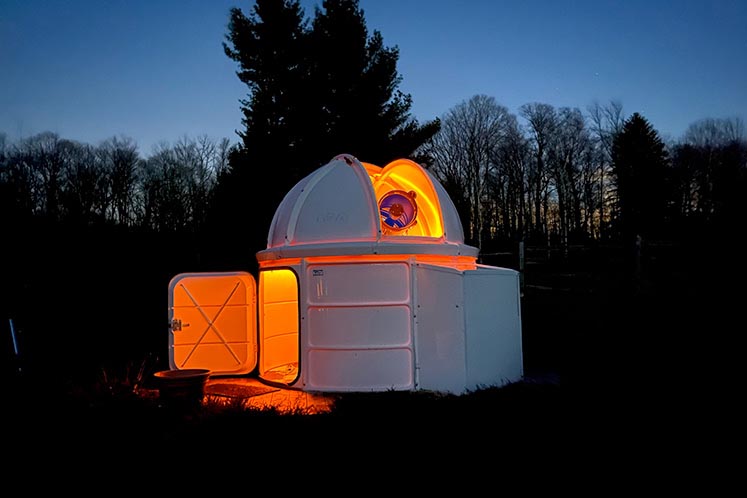
Brad Heide’s Belfountain observatory. Photo by Greg O’Toole.
At age eight, Brad owned his first telescope, a three-inch refractor. At 15, he told his dad he wanted to upgrade, so he worked jobs over the summer to pay half the cost of a new eight-inch telescope. From then on, telescope accessories were high on Brad’s Christmas lists. One of those accessories was an adapter that connected his camera to the telescope. Brad planned to embark on a little astrophotography: photographing the stars.
Necessary, though, was a costly motor drive add-on to precisely compensate for the earth’s rotation to enable long-exposure photographs. Rather skint at the time, Brad decided to build his own. At a local hobby shop, he bought a motorized drawbridge for a model train set, removed the motor, scavenged some gears from a broken icemaker at home, and jury-rigged a drive for his telescope. It worked perfectly.
He still has the makeshift add-on and the telescope he used as a teenager, fond reminders of his early passion for astronomy and his engineering savvy. But now in his 50s, Brad has upped his game. He studies and photographs the heavens through a Meade 14-inch reflector telescope housed in his backyard observatory in Belfountain.
For Brad, this impressive setup is simply the latest step in a lifelong love affair with the cosmos and with the technology that enables him to nurture this love. The wide lens on his telescope offers excellent light-collecting power, allowing him to see dimmer objects with greater clarity. As it should – at a cost of about $12,000.
The telescope is mounted on a concrete pier that provides the all-important stability necessary to do astrophotography. It is housed inside a $4,000 observatory purchased from the Canadian company NexDome and resembling a scaled-down version of the famous Palomar Observatory in California. Citing a more typical big-ticket item that other men his age sometimes splurge on, Brad jokes that the telescope and observatory are his “sports car.”
In late April, with a clear night sky in the forecast, I visited Brad at his observatory. Brad’s partner, Matt Galbraith, joined us, along with their twin eight-year-old girls, Emma and Kaitlyn. Greg and Genevieve O’Toole, neighbours from across the street, arrived with their children, 15-year-old Matt and 12-year-old twins Ally and Mikey.
Expectation rose as our celestial viewing party waited for the skies to darken. The planet Mercury got the ball rolling. Because it orbits so close to the sun, Mercury is always low to the horizon. The children, with their sharp young eyes, easily found Mercury’s tiny point of light in the glow of the setting sun. I struggled and, of the assembled sky watchers, was the last to see it, first through my binoculars and then with my naked eyes – barely.
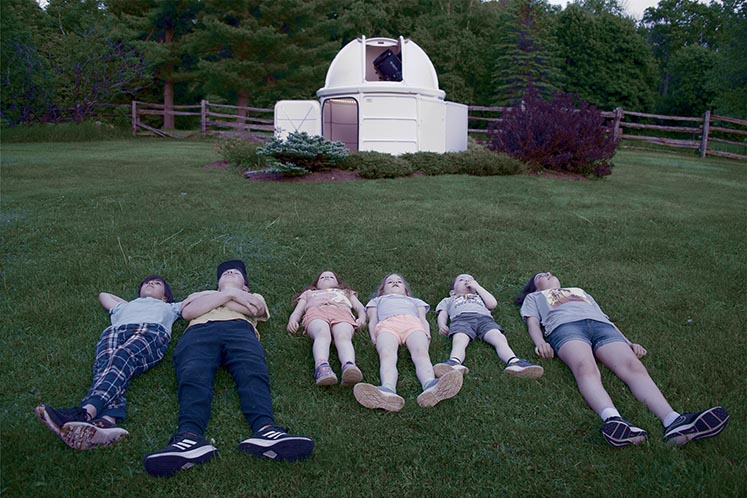
Stargazers: (From left) Mikey O’Toole, Matt O’Toole, Kaitlyn Heide-Galbraith, Emma Heide-Galbraith, Liam Heide-Galbraith and Ally O’Toole. Photo by Pete Paterson.
In Brad’s yard, the stargazers lay on their backs and looked upward as Brad searched for our next celestial marvel. Simple, effective and free, this type of star gazing serves as an excellent introduction to the wonders of the universe. Constellations can be puzzled out and this kind of technology-free viewing will also reveal meteors and satellites. No one really needs a $12,000 telescope for entry-level astronomy. All that’s necessary are clear, dark skies and curiosity. Add a pair of binoculars to these modest requirements and the experience is further enhanced.
The first constellation identified by the prone sky watchers was Orion, the hunter, a well-known winter constellation, still visible, but soon to be leaving our night skies for much of the spring and summer. Constellations such as Orion are a great way to introduce children to the wonders of the universe. They stoke the imagination and have memorable, evocative names: Orion, the hunter; Taurus, the bull; Leo, the lion.
The best-known constellation, at least in the Northern Hemisphere, may be the Big Dipper. To be precise, it is officially known as an “asterism,” which I didn’t know before writing this article. So it is not an official constellation; rather, it’s made up of the seven brightest stars in Ursa Major, a much larger constellation also known as the Great Bear. Semantics, I’d say; it will always be a constellation to me.
Over the centuries, the visibility of the Big Dipper has endowed it with many names, including the Plough, the Saucepan and the Great Wagon. My favourite is the Drinking Gourd, a name that may have been used by enslaved people in their furtive nighttime journeys northward to escape bondage in the South.
Hollowed-out gourds were once used to ladle water in rural America. A popular folk song is called “Follow the Drinking Gourd.” And Harriet Tubman, the renowned Underground Railroad “conductor,” is reported to have used the term. But regardless of what those fleeing slavery called it, they probably lined up the two stars at the outer edge of its ladle to find the North Star. Unlike other stars, the North Star’s position in the night sky is fixed relative to Earth, so it offered a sure guide to the north and freedom.
Constellations serve as useful and simple maps for locating stars and nebulae. Brad pointed out Betelgeuse, a red supergiant star that defines the left shoulder of Orion. Betelgeuse is stupendous – 500 to 1,000 times the diameter of our sun! If Betelgeuse traded places with our sun, it would extend well past the orbit of Mars. The inner planets, including Earth, simply wouldn’t exist. The children had fun with the name, pronouncing it, as I always have, “Beetle Juice” – which apparently isn’t far off the mark.
Brad was able to point his telescope through the leafless branches of the trees bordering his backyard to capture the Orion Nebula in the “sword” of Orion. Nebulae are vast clouds of dust and gas that give birth to new stars. The Orion Nebula, at two million years old an infant by celestial standards, is the closest star-forming region to our solar system. Just visible as a smudge in a pair of binoculars, its true splendour is revealed under greater magnification. A leading explanation for its existence proposes that 10 or 20 million years ago, the area of space it now occupies was populated by a group of supermassive stars. As is the case with most massive stars, they aged quickly and then exploded in a series of cataclysmic blasts called supernovas.
Supernovas like this create the heavy elements that planets such as Earth are made of – the elements that enable complex chemistry. In fact, the elements created in these prodigious explosions make not only planets, but also us humans. “Woodstock,” Joni Mitchell’s popular song, released in 1970, put it well: “We are stardust, / We are golden.” The great Carl Sagan, astronomer and science communicator, described it like this: “The nitrogen in our DNA, the calcium in our teeth, the iron in our blood, the carbon in our apple pies were made in the interiors of collapsing stars. We are made of starstuff.”
Another Sagan quote, building on his “starstuff” theme, has significance for our star-viewing party in Belfountain: “The cosmos is within us. We are made of starstuff. We are a way for the universe to know itself.”
I thought about this as we watched the sky in Brad’s backyard – starstuff contemplating the stars. It’s as if the universe has invented a way to understand itself.
Brad remains an enthusiastic astrophotographer. On our observatory night, he directed his telescope’s gaze to the Whirlpool Galaxy, aka Messier 51A. When I saw this galaxy gradually congeal on the laptop computer linked to the camera attached to Brad’s telescope, I understood why it’s one of his favourite photo subjects. A breathtaking and awe-inspiring pinwheel of hundreds of millions of stars, the Whirlpool has the classic lines of a spiral galaxy. But heightening its appeal is Messier 51B, a smaller galaxy that interacts with and is linked to the Whirlpool by a great bridge of interstellar dust.
To photograph something like the Whirlpool Galaxy, Brad says, “At first, I take one-second exposures which reveal views similar to what you see in the eyepiece – just the central bulges of the galaxies are visible, because they are the brightest parts. Then I increase the exposures to 10 seconds and suddenly the spiral arms pop out on the screen.”
But the process isn’t over yet. “After that I stack the images from the camera using software on the laptop,” he adds. “This stacking of multiple exposures enhances images by cancelling out low-light camera noise. I also ‘stretch’ the brightness levels of the pixels to make dim parts of the image brighter while not increasing the brightness of stars that may also be in the field of view. I then use software to help cancel out light pollution by dimming the sky background without dimming the galaxy itself.”
It’s all a little more complicated than simply pressing the shutter button of the camera! Brad, however, explains that this process is not a Photoshop-like manipulation. He doesn’t add anything to the image itself; he just uses technology to draw out what’s already there. The results of this technological tweaking, as I witnessed, can be impressive.
The light from the Whirlpool Galaxy travelled about 25 million years before reaching Brad’s telescope and our eyes. This is just one example of the enormity of space. This enormity is enough to make some of us uncomfortable. It speaks to how infinitesimally small our planet is – and how small each of us is.
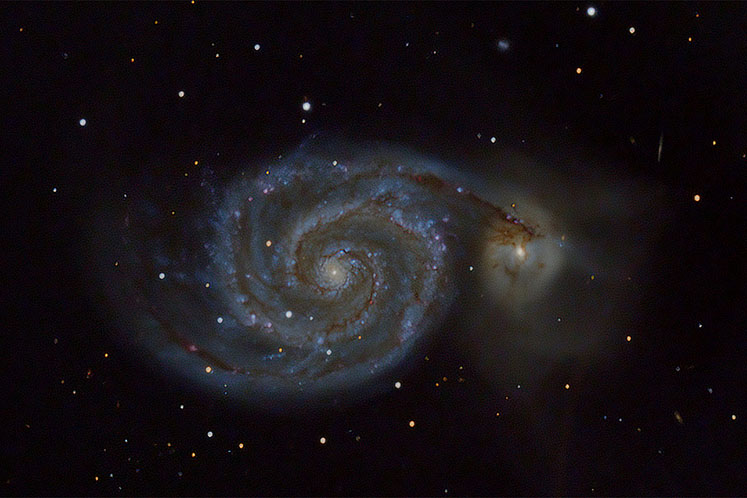
Closeup of the Whirlpool Galaxy (M51) in Ursa Major, just below the Big Dipper handle. It is actually two galaxies that have collided.
But there is value in this diminishment because it teaches humility, a quality that, arguably, we need more of. I like amateur astronomer Benhur Senabathi’s take on this: “As you spend a few minutes every day looking and interpreting the night sky, something changes your mindset. You see the world not how you want to but for what it is. You cherish the time you have with your loved ones, and you know that the small blip, which you are in the cosmic timeline, is all about being humble and caring for one another.”
Looking at the stars and contemplating the vastness of space also leads to a sense of wonder. How many galaxies? Current estimates, according to Brad, offer a hundred billion as the number. A rough estimate of a hundred million stars per galaxy suggests that the total number of stars in the known universe is staggering. And this already nearly inconceivable total will surely increase as we hone our ability to see farther into space.
Of course, another mind-boggling calculation would be an estimate of the number of planets orbiting those stars. When I was a boy, no planets beyond our solar system were known. In the late 1980s, when I began teaching astronomy to Grade 6 students, scientists still knew of only the nine planets orbiting our sun, and this number was reduced to eight after Pluto was designated a dwarf planet.
Then, in 1992, came news of a spectacular discovery: two planets orbiting a neutron star 2,300 light years away. Shortly afterward, the flood gates opened and now, 30 years after the discovery of the first exoplanets – planets that orbit a star other than Earth’s sun – science has revealed more than 5,000!
That astronomers on a little planet in the suburbs of the Milky Way galaxy have been able to reach out with their instruments to find so many planets over the yawning gulfs of space is amazing. But it’s really a drop in the ocean. The prevailing belief is that all stars have at least one planet. There are likely hundreds of millions of planets in our galaxy alone.
Even if future astronomers can study only the 5,000 planets known in 2022, the discoveries will be astounding. The modest complement of planets and their moons orbiting our sun have yielded surprise after surprise to our robotic spacecraft. An illustration of this is the remarkable diversity of Jupiter’s four largest moons, discovered by Galileo in 1610.
The surface of Europa is billiard-ball smooth and may cap an ocean of water double the volume of the oceans on Earth. Ganymede, Jupiter’s largest moon, is bigger than the planet Mercury. Like Europa, it may have a vast ocean under its icy surface. Io has hundreds of active volcanoes, some spewing lava dozens of kilometres above its surface. Io’s surface is constantly being renewed by this volcanic ejecta, but Calisto, another of Jupiter’s large moons, has an ancient, cratered surface, an enduring record of the meteors and asteroid strikes that have pummelled it for billions of years.
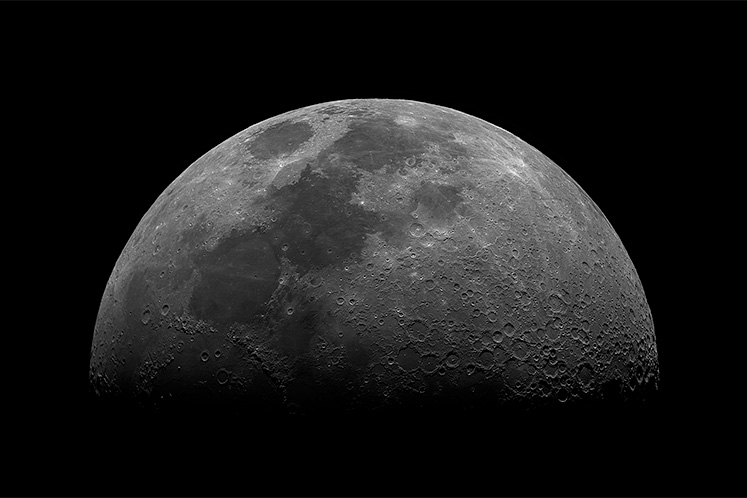
Craters on the Moon. Photo by Brad Heide.
On our space-viewing night, none of us planned to stay around for the rise of our moon at about 3 a.m. Like Calisto, our moon has an old surface pockmarked by craters, revealed in exquisite detail through binoculars and low-magnification telescopes. Though our star party missed the spectacle of the moon, Earth’s natural satellite, we were treated to a light show provided by artificial satellites. All of us, even seasoned astronomer Brad, were astonished when a bright streak appeared in the sky above his observatory. Individual points of light were visible within the streak. My mind flailed for an explanation.
Brad and his sky-watching neighbour Greg quickly solved the mystery. We were seeing one of Elon Musk’s SpaceX Starlink “satellite trains” shortly after launch. Greg later confirmed that a series of 53 SpaceX satellites had been launched earlier that day, part of an initiative to provide low-cost internet service to remote locations on Earth. Soon those 53 satellites would disperse, becoming part of a network of 12,000 internet satellites orbiting Earth. But this is only the start. Musk has applied to launch 30,000 more.
Predictably, not everyone is happy about the growing proliferation of satellites circling our globe. Professional astronomers are concerned that satellites may interfere with astrophotography, and Brad acknowledges this concern. But, he adds, “For hobbyists like myself, they’re a nuisance that’s not insurmountable.”
The satellite trains will be visible from Earth only shortly after dusk or shortly before dawn, when the sun is just below the horizon and can illuminate them. Brad doesn’t think they will be a problem when most astrophotography is done in the dark skies that prevail well after sunset and well before dawn. He also stresses that the multiple exposures that serious astrophotographers take enable them to discard those that may have captured the streak of a satellite. Multiple exposures also serve to average out the trails satellites leave, rendering them invisible in the final image.
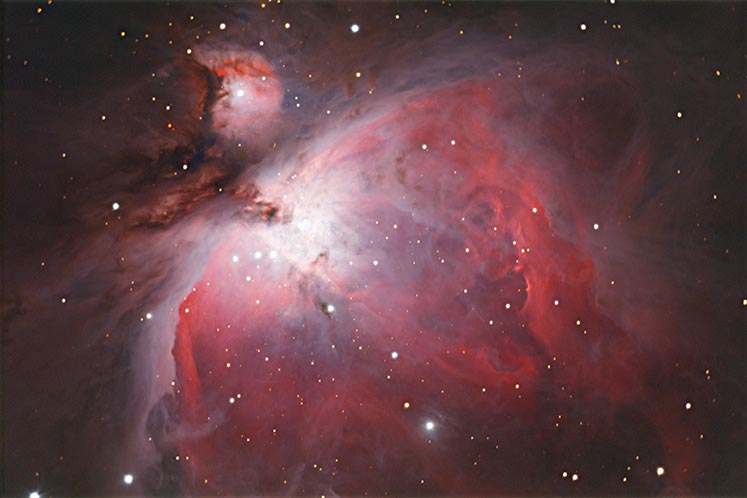
The Orion Nebula, located in The Hunter’s “sword,” is a vast cloud of dust that will give birth to new stars. Photo by Brad Heide.
Of more concern to photographers in the 21st century is light pollution. Great swaths of urban Canada are deprived of the glory of the night sky because of the glow of millions of electric lights. This is at least a minor tragedy for those of us who cherish the beauty of the night sky. It spells a diminishment of wonder for children and adults alike. While it is not impossible to develop an appreciation of the universe without being able to see the stars, it is certainly more challenging.
Living in Belfountain, the children at our star party are fortunate. On clear nights, our Milky Way galaxy is still visible. But over the dozen years that Brad has lived in the village, he has noticed a “slow creep” of light from the south – from Brampton and from the southern part of Caledon, where suburbia is growing. “The north and the west are still quite good,” he says.
Brad says light pollution isn’t a big problem for viewing and photographing planets, but it can interfere with seeing dim objects such as distant nebulae and galaxies. Few places in southern Ontario are completely unsullied by light pollution. But thankfully, some reasonably dark locations in southern Ontario can still be found, including much of Headwaters beyond the large towns.
There will be wonders aplenty to engage budding astronomers in the years ahead. Today’s children are living in a time of frenetic space exploration. Marvels will be discovered by telescopes and by robotic – and perhaps even human – missions to other planets and moons in our solar system. But, as Brad knows, the spark to ignite a lifelong passion for astronomy in our children needs to be kindled by wise parents and teachers.
On that clear April evening in Belfountain, with spring peepers singing in the distance and the night sky gradually revealing its wonders, Brad and Matt and their neighbours Greg and Genevieve did just that, by inviting their children to look up and be amazed. Eight-year-old Kaitlyn Heide-Galbraith wondered how many light years it would take for her to reach the stars. Her twin sister, Emma, pondered what stars are made of and why planets are different colours.
Greg and Genevieve’s children expressed their curiosity as well. Twelve-year-old Ally loved seeing the stars and raised a question that bedevilled me as a youngster and still does today: “Looking at space makes me wonder whether it has an end or not.” Her 15-year-old brother, Matt, offered an esthetic take on the universe: “Space is one of the most beautiful things to look at.”
And then there were the extraterrestrial musings of 12-year-old Mikey and his insight that we still have much to learn: “There is so much out there we don’t know. Tons of other species or even human colonies could be out there.”
I don’t know about “human colonies out there.” But I do know about yearning to find out whether we are alone in the universe. As a child, I shone flashlights upward at night, sending their photons toward the stars at the speed of light, fancying – hoping – that I could be connecting with aliens.
Let’s open the doors of the universe for our children. Let’s go together into the darkness, look up and kindle the sparks that can lead to a lifetime of awe and discovery.
Astronomy 101 Glossary
Universe
Everything. All solar systems, galaxies, dust clouds, dark matter, black holes. Everything.
Galaxy
Hundreds of millions of stars and clouds of gas and dust held together by gravitational attraction. Each of those stars is the centre of a solar system.
Solar system
A star, such as our sun, and all the celestial objects that orbit it, including planets and their moons, dwarf planets, asteroids and comets. Our solar system has eight planets.
Nebula
A vast cloud of dust and gas. Many nebulae are star-making factories in which gravity pulls the dust and gas together to ignite stars.
Supernova
An exploding star at the end of its life. Many of the elements that sustain life are created in the core of stars and then seed the universe when the stars explode.
Celestial happenings this summer and fall
Second half of June
Just before dawn, Mercury, Venus, Mars, Jupiter and Saturn – the five planets in our solar system visible to the naked eye – can be seen in their correct order.
Early to mid-August
The height of the annual Perseid meteor shower, a great time to lie back on a lawn chair with friends and family and look up. The absolute peak time is expected to be August 12 to 13, but this year the bright light from a full moon will unfortunately diminish the experience.
November 8
Total eclipse of the moon. Rise early for this one. In our area, the moon will be completely shadowed by Earth at 5:59 a.m.
December 12, 13
The annual Geminid meteor shower. As with the Perseids, however, the bright moon will intrude again.
Apps to help discover the universe
Sky Tracker Lite Live Sky Map
This app provides detailed maps of the section of sky your phone is pointing at, including planets, constellations and notable stars.
Stellarium (stellarium-web.org)
Touted as “a free open-source planetarium for your computer,” this app shows the night sky and the celestial phenomena, including
stars, planets and constellations, you can expect to see in your area at particular times. The especially enthusiastic can download a deeper dive from stellarium.org.
These are only two of many fine computer programs to help you appreciate the universe.
Related Stories
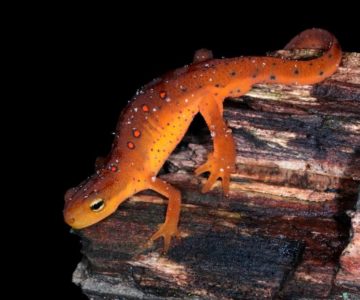
Adapting to Survive
Mar 29, 2022 | | EnvironmentAnimals use camouflage, poison and deception to live another day.
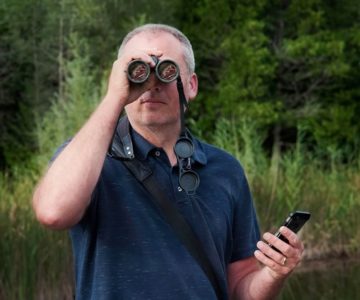
Calling All Citizen Scientists!
Sep 24, 2021 | | EnvironmentAll you need is a smartphone and a love of nature to make valuable contributions to conservation science.
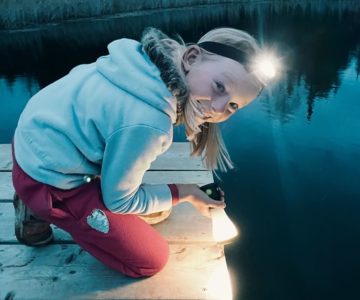
Wild Nocturne
Jun 22, 2021 | | EnvironmentGrab a flashlight and head out on a hike after sundown and get to know the creatures of the night – including moths, salamanders and frogs.
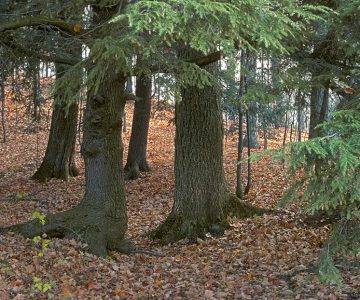
A Forest is More Than Its Trees
Sep 18, 2020 | | EnvironmentFrom deep in the earth to high in the sky, forests shelter teeming life.












